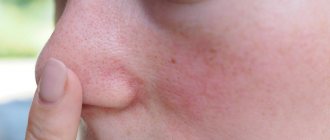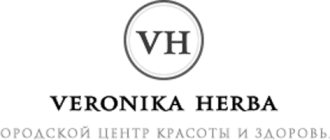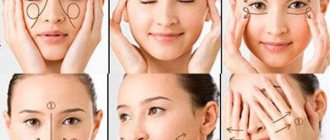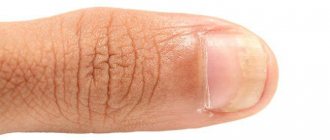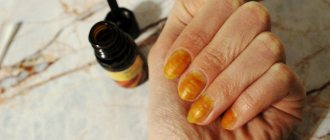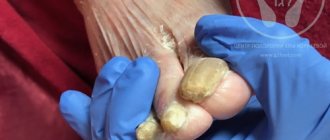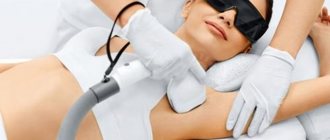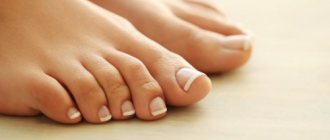- The nail hurts
- Calluses
- Nail deformities
- Corns
- Ingrown nail
- Crack on the foot
- Nail fungus
- Diabetic foot
- The nail has turned yellow
- SMART pedicure
- Nail fungus
- On foot
- Symptoms
- Treatment
- Laser Genesis Treatment
Traditionally, treatment of nail fungus begins with local treatment of the affected nail plate and periungual fold with antifungal agents. In more advanced cases, systemic drugs are prescribed, which, due to their high toxicity, can lead to complications. Therefore, our specialists have recently given preference to laser therapy for onychomycosis, which is carried out on Xeo Cutera equipment using the Laser Genesis attachment.
Treatment of nail fungus with laser
A beam of light directed by a laser penetrates the affected area and destroys cells using heat. The surrounding healthy tissue remains intact.
Why is laser preferable to other treatment methods?
- Laser treatment of nail fungus is recommended when other means no longer help.
- Unlike antimycotic ointments and medications, laser gives immediate results and has no side effects.
- The treatment is safe and painless. The laser is equipped with a cooling system that prevents tissue overheating.
Preparing for treatment
Before signing up for this procedure, you must visit a specialized specialist and accurately determine the correctness of the diagnosis and the need for treatment. Typically, the doctor takes a scraping and performs a microscopy to determine the presence of pathogenic fungi.
There are no strict preparation rules for the procedure, but you should follow these recommendations:
- wash your hands and feet thoroughly with antibacterial gel;
- if there is a varnish coating, remove it;
- if you have onychogryphosis (thickening of the nail), you should contact a podiatrist and remove all layers;
- For the procedure, if it is performed on your feet, take a pair of clean socks, which you will put on after the session.
Advantages of laser treatment for onychomycosis:
- the procedure takes no more than 30 minutes;
- no blood pressure control required;
- laser exposure does not cause pain;
- the laser beam penetrates into the deep layers of the skin and destroys all infected cells;
- laser treatment is not dangerous for allergy sufferers;
- The laser is effective against all types of fungus.
- However, laser removal is not for everyone. This method should be avoided by pregnant women, people with diabetes, cancer or severe chronic diseases.
Indications
Laser treatment of mycosis is carried out in the clinic by a specialist who will fully prepare the patient for this procedure and tell you how to maintain the results of the procedure so as not to become infected again.
Indications for using laser are:
- extensive foci of fungus;
- ineffectiveness of conservative treatment;
- inability to use local antifungal drugs;
- allergic reactions to drugs;
- severe damage to the nail plates and matrix on the hands and feet.
Result of laser treatment for nail fungus
The effectiveness of the treatment is assessed as the nail grows - this usually takes 6-9 months. To maintain immunity and kill any remaining fungal spores, or if the infection may spread to other fingers, your doctor may prescribe antifungal medications.
After removing the fungus using a laser method, patients have a positive result for at least a year. To prevent the disease from returning, it is enough to follow simple hygiene rules and monitor the condition of your legs and feet. According to research results, onychomycosis disappears forever in 80% of patients.
Contraindications
Like any method, laser intervention has contraindications:
- acute inflammatory processes;
- oncological diseases;
- infections of viral etiology;
- diabetes;
- bearing a child and lactation period;
- streptoderma;
- connective tissue diseases;
- incompatibility with taking other medications;
- disorders of the immune system and use of immunomodulators;
- epilepsy;
- psychoemotional disorders.
Also prohibited for starting treatment are peeling and visiting a solarium. You need to wait a couple of weeks before starting laser treatment for mycosis.
It should also be noted that the laser is not used immediately after surgical removal of internal organs. Treatment can only be carried out after complete recovery.
conclusions
Taking into account our data, we can conclude that laser therapy for onychomycosis with the Fotona Dynamis SP 1064 nm neodymium laser is a modern method of treating the pathology, demonstrating high efficiency (86% cure). The undoubted advantages of laser therapy compared to standard treatment include a significant reduction in treatment time (only four sessions versus 3 months of therapy), the absence of side effects, ease of implementation, and complete safety for the patient and body tissues during use. The results obtained indicate that this treatment method should be preferred in cases of:
- damage by dermatophyte flora;
- with minor damage (up to 50% of one nail);
- when other methods of standard therapy cannot be used (childhood, women during lactation, patients with severe liver dysfunction, the elderly);
- as a starting protocol for local treatment before prescribing the main course of treatment with systemic drugs.
This technique significantly expands the doctor’s capabilities as a modern and fast method of sterilizing the nail plate. The disadvantages of the technique include the fact that, according to our data, this approach is ineffective as monotherapy in the treatment of onychomycosis caused by mold flora (yeast, aspergillum - no more than 40% of cure) and in combined pathology (nail psoriasis). Although it can serve as a significant addition to systemic antimycotic therapy in these cases. Research in this direction should be continued.
Literature
1. Sergeev Yu. V., Sergeev A. Yu. Onychomycosis. Fungal nail infections. – M.: GEOTAR Medicine, 1998. 2. Kubanova A. A., Potekaev N. S., Potekaev N. N. Guide to practical mycology. – M.: Financial publishing house “Business Express”, 2001. – P. 71–85. 3. Sergeev A. Yu. Systemic therapy of onychomycosis (a manual for doctors). – M., 2000. – 28 p. 4. Skin and venereal diseases: Handbook / Ed. O. L. Ivanova. – M.: Medicine, 1997. – P. 166–167. 5. Sergeev A. Yu., Sergeev Yu. V. Fungal infections. Guide for doctors. – M.: Binom Press LLC, 2003. – P. 93–97. 6. Kozarev J. Novel Laser Therapy in Treatment of Onychomycosis // Journal of the Laser and Health Academy Vol. – 2010, No. 1. 7. Ghannoum MA, Hajjeh RA, Scher R, et al. A large-scale North American study of fungal isolates from nails: The frequency of onychomycosis, fungal distribution and antifungal susceptibility patterns // J Am Acad Dermatol. – 2000; 43:641–648. 8. Gupta AK, Ryder JE, Baran R. The use of topical therapies to treat onychomycosis // Dermatol Clin. – 2003; 21:481–9. 9. Havu V., Brandt D., Heikkila H., Hollmen A., Oksman R., Rantanen T., et al. A double-blind, randomized study comparing itraconazole pulse therapy with continuous dosing for the treatment of toe-nail onychomycosis // Br J Dermatol. – 1997; 136:230–4. 10. Vural E., Winfeld HL, Shingleton AW, Horn TD, Shaf rstein G. The effects of laser irradiation on Trichophyton rubrum growth // Lasers Med Sci. – 2008; 23: 349–353. 11. Meral G., Tasar F., Kocagoz S., et. al. Factors affecting the antibacterial effects of Nd:YAG laser in vivo // Lasers in Surg Med. – 2003; 32(3):197–202. 12. Smijs TG, Schuitmaker HJ Photodynamic inactivation of the dermatophyte Trichophyton rubrum // Photochem Photobiol. – 2003; 77:556–560.
Advantages and disadvantages
Fungal nail diseases cause a lot of unpleasant moments for a person. You want to remove mycosis as quickly as possible, and in this regard, laser therapy is a promising method. Whatever the infection, one session takes no more than twenty minutes. The method is suitable for both adults and children; it quickly removes the symptoms and causes of the problem.
There are no side effects from the laser technique, and antimycotic drugs often have a bad effect on the liver or kidneys. The course of medication is taken for up to six months.
The positive aspects include the following:
- there is no pain during the process;
- healthy tissues remain intact;
- no additional funds required;
- the course is developed individually based on diagnostic data and the patient’s condition.
Signs of fungal infection
Before starting treatment for the disease, you need to make an accurate diagnosis. Signs of fungal infection vary depending on the type of fungus. This helps the doctor to predict the type of pathogen during a routine dermatological examination:
RUBROPHYTIA:
- All toenails are damaged,
- The fungus affects the entire nail, top, bottom edge, side surfaces,
- Yellowish and white stripes appear in the thickness,
- Hyperkeratosis leads to thickening of the nail,
- The shade of the nails changes and becomes yellowish,
- Brittleness appears, the edge of the nail becomes uneven and sharp.
Epidermophytosis:
- Only the big toe and little toe are affected,
- The fungus is localized on the entire surface of the nail,
- The remaining symptoms are similar to rubrophytia.
NAIL CANDIDOSIS:
- Only the distant edge of the nail plate is damaged,
- The nail becomes, the edge breaks off on the side and the nail has a characteristic beveled cut,
- The color of the nail changes from yellow to brown,
- The skin around the nail is inflamed, painful and may contain purulent discharge.
NAIL MOLD:
- Only in old age
- Nail color black, gray, yellow-green
- Deformation of the nail in the form of a pointed cone,
- Big toes suffer.
NOTE! Knowing the main symptoms of onychomycosis will allow you to recognize the disease at an early stage and consult a doctor in time. With a long course of the disease, serious consequences and complications may arise, requiring long-term therapy and even surgical intervention. Separation of the nail from the nail bed is a common sign of the disease, occurring in advanced cases, making it impossible to wear shoes or play sports.
Diode
The wavelength of the diode laser system is 1064 nm. The beam penetrates tissue to a depth of 7 mm, heats fungal pathogens to 42-45 °C and evaporates tissue affected by mycosis. Healthy areas are not affected.
Diode equipment is rarely used to remove fungus. It causes discomfort during therapy.
The procedure will be cheaper than treatment with other types of laser. But it sometimes takes up to 8 sessions to completely eliminate the problem.
Causes of the disease and its prevention
The main reason for the appearance of pathogenic fungi on the nails is damage to the skin of the foot or nail plate. In such cases, treatment of the pathology must begin immediately, without delaying it for a long time.
Other factors leading to the occurrence and development of this disease include:
- direct contact with some household items for public use: rubber shoes or rugs, accessories for manicure and pedicure;
- excessive moisture caused by wearing synthetic socks or stockings;
- frequent use of false nails;
- diseases of the endocrine system;
- immunodeficiency diseases.
However, this disease can be prevented if you follow a number of simple rules:
- when visiting swimming pools and saunas, you must have individual rubber shoes with you;
- promptly eliminate calluses and dry feet;
- avoid minor injuries and wounds of the feet and hands;
- use talc and powders for excessive sweating of the feet;
- in case of immunodeficiency, increase immunity;
- change socks or stockings every day.
Such simple actions can be used as preventive measures to prevent onychomycosis. If you strictly follow these rules and strictly follow them, then there will be no need to treat the disease [2][3].
Neodymium laser
The neodymium Nd:YAG laser is a non-ablative laser, which means that the laser radiation used does little to no damage to the epidermis. The operation of a neodymium laser is based on thermal effects, but no “open wound” remains after such an effect; the destroyed tissue does not evaporate, but remains in the skin. When exposed to a neodymium laser on the skin or surface of a scar, the laser beam penetrates inside and has a selective effect on the internal structures of the dermis or scar tissue.
Erbium
Erbium laser helps against nail fungus in 5-6 procedures. The treatment is called “cold” because the installation does not cause burns or tissue injury. The equipment is used in difficult cases when it is necessary to cope with mycosis in a hard-to-reach place or in an advanced stage.
The beam seals the vessels that the fungus feeds on. Microorganisms cannot develop further and die. Erbium laser equipment operates more delicately than diode laser equipment. But the nail is still partially destroyed.
Reasons for appearance
A healthy, strong immune system protects the body from the invasion of fungal infections. As soon as the protective immune forces weaken, there is a danger of invasion and active proliferation of microbes. Conditions under which fungal infections most often develop:
- weakened immune system;
- long-term use of antibiotics;
- metabolic disease;
- endocrine pathologies;
- frequent visits to public places (baths, saunas, water parks);
- wounds on the skin of the legs, abrasions, corns;
- elderly age.
Nail fungus is caused by one of the types of microorganisms: yeast microorganisms (5% of cases), dermatophytes (common most often), mold fungi (rarely). Often the infection is caused by parasitic fungi - dermatophytes, of which Trichophyton rubrum (90%) stands out.
A person becomes infected through contact and household contact. The initial signs of damage are the appearance of white or yellow spots in the thickness of the nail. Spores of the causative agent of mycosis can be on the floor, on towels, on rugs, in shoes. Warm places with high humidity potentiate the growth and reproduction of fungi.
Study protocol
Between December 2010 and November 2012, we treated 195 patients with an established diagnosis of onychomycosis. A total of 416 fingers were treated. Only those clients whose diagnosis was laboratory confirmed were taken into treatment, regardless of the severity of the clinical picture. Control of cure was carried out visually (by comparing photographs) and laboratory (by direct microscopy at the 3rd, 6th and 9th month after treatment). All patients were prescribed a course of laser therapy with a long-pulse neodymium laser Fotona Dynamis SP (1064 nm), which consisted of 4 laser therapy sessions with an interval of 7 days. The laser beam was applied to the entire nail plate by gradually moving the beam in a spiral, as shown in Photo 4. Patients were also given recommendations for preventing the disease at home. In cases that initially presented a certain risk of non-cure (according to Sher RK, 2007), namely: hyperkeratosis, damage to more than 50% of the nail surface, as well as immunosuppression, as well as when mycelium was re-identified during laboratory testing after a course of laser treatment, patients were prescribed a systemic antifungal therapy according to the standard pulse therapy regimen. This had to be resorted to in 21 patients (10.8%). Patients with significant hyperkeratosis were advised to treat the nail with keratolytic agents to improve penetration of the laser beam into the nail. Such preliminary preparation was required only in 12 patients out of 195 (6.2%).
The essence of laser therapy for onychomycosis is that at the moment the laser beam comes into contact with the chromophore (mycelial cell of the fungus), light energy is transformed into thermal energy, the local temperature rises to 45–53 ° C, which is sufficient to denature the protein of the fungal cell. This was confirmed by recording changes in local temperature on the surface of the nail during laser treatment. We measured the temperature using a FLIR ThermaCAM thermal imager. Since heating occurs for only 15 milliseconds, which is less than the time of thermal relaxation of skin cells, the tissues have time to cool down and excessive heating of the surrounding tissues does not occur - subjectively, patients noted the absence of pain (46%) or a feeling of slight warmth (54%). Therefore, the patients were not given anesthesia. To ensure maximum comfort during processing, local cooling with a flow of cold air was used (Cryo 6 unit, Zimmer, Germany). Tolerability of the procedures was 100%; no side effects were identified during treatment.
What is unique about the FOTONA SP SPECTRO laser system?
FOTONA SP SPECTRO is a unique patented laser system created more than 40 years ago in Slovenia by Fotona, a recognized world leader in laser production. Fotona's innovative developments have made it possible to achieve a unique combination of efficiency and safety of laser procedures. The FOTONA SP SPECTRO device can be used to perform more than 50 types of procedures, allowing you to solve a wide range of aesthetic problems. An entire multidisciplinary laser clinic and a huge number of different procedures are collected in one mobile building.
The areas of application of FOTONA SP SPECTRO are truly diverse:
- “Cold” and “hot” peelings.
- Laser dermabrasion.
- Fractional laser rejuvenation of the face, décolleté, etc.
- Deep dermal rejuvenation.
- Laser hair removal for all hair types (by AREA).
- Laser treatment of nail onychomycosis.
- Removal of viral warts.
- Aesthetic polishing.
- Resurfacing of scar tissue.
- Superficial non-ablative rejuvenation.
- Fractional rejuvenation using FRAC3 technology (BY AREA).
- Laser treatment for acne.
- Laser removal of arterial and venous vessels.

